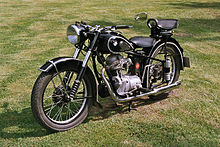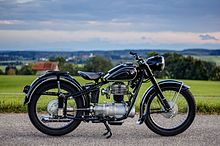BMW R 25/2
The BMW R 25/2 was a motorcycle by the German manufacturer BMW that was built from 1951. It was the successor to the R 25 .
history
development
The predecessor of the R 25/2 was the BMW R 25 model with telescopic fork and straight-travel rear wheel suspension. The R 25/2 differs only slightly from this. In contrast to the R 25, the R 25/2 now has an idle control light integrated in the headlight housing, a "dovetail muffler" for the silencer, and various chrome-plated components that were still painted black on the R 25.
marketing
The price for the motorcycle was 1990 German marks at the end of 1951 . Production ended in October 1953 after 38,651 units with the start of series production of the R 25/3 .
Design features
The double tubular frame is welded from tubular steel with laterally attached spherical heads for sidecar operation. The Steib LS 200 [1] was a suitable sidecar, but it required a modified gear ratio in the final drive and an exchange of the speedometer . The fenders and the tank are made of sheet steel. The front mudguard has the curved dirt flap incorporated into the sheet steel, which is missing in the later models R 26 and R 27. The engine block, like the gearbox and the rear axle drive, is made of cast aluminum. The silencer silencer is attached directly to the frame with sheet metal straps.
engine
The engine is a longitudinally installed single-cylinder four-stroke engine with a side camshaft and outside next to the cast iron cylinder in chrome-plated steel tubes running bumpers. These actuate the hanging valves in the cast aluminum cylinder head via rocker arms (OHV). The rocker arm and piston pin are mounted in bronze bushings, the crankshaft in roller bearings. The camshaft is driven from the crankshaft via a simplex chain. The oil pump is a gear pump in the oil pan, which is driven by the camshaft via a worm drive (reduction).
The direct current alternator sits on the front stump of the crankshaft, together with the charge regulator for the lead battery, encapsulated splash-proof under a sheet steel cover. On the rear stump of the crankshaft sits the heavy flywheel (with the ignition timing mark - visible in the inspection hole), which accommodates the single-disc dry clutch. The clutch is operated via an axial bearing with a push rod running through the hollow main shaft of the gear unit. The carburetor is a 22-series Bing float chamber carburetor (model: 1/22/44) with a conical needle in the round slide. The wet air filter element is located directly on the carburetor. The suction filter is a steel mesh that is wetted with oil on which the dust adheres. It is used for coarse filtering of the intake air. The air filter is not changed for maintenance, but cleaned and re-wetted with oil.
drive
The drive train requires an angularly movable torque transmission element at the transmission output. In addition, a black rubber four-hole disc (Hardy disc) is pushed onto the two-finger flange of the gearbox on this model, which transfers the torque from the gearbox output shaft to the two-finger mount of the cardan shaft. As with the successor models, this Hardy disc is reinforced with a chrome-plated steel ring all round for reasons of stability. The cardan shaft to the rear wheel is high-gloss chrome-plated and runs open. The universal joint of the cardan shaft attached to the angular gear is covered with an aluminum screw cap against dust. A rubber seal that rotates with the shaft runs against this screw cap and keeps loose dirt out of the universal joint. The bevel gear in the cast aluminum body is a bevel gear with 90 ° deflection.
Wheels, brakes
The R 25/2 was fitted with half-hub brakes and 19 ″ steel rims (“can end brakes”), which did not achieve the same deceleration values as the aluminum hubs of the successor models with a larger braking surface.
Technical specifications
| Parameter | Data of the R 25/2 | ||
|---|---|---|---|
| drilling | 68 mm | ||
| Hub | 68 mm | ||
| Displacement | 247 cc | ||
| power | 12 hp (8.8 kW ) at 5800 min -1 | ||
| Compression ratio | 6.5: 1 | ||
| Top speed | 105 km / h (lying), 80 km / h with a sidecar | ||
| Empty weight | 142 kg | ||
| total weight | 300 kg | ||
| Tank capacity | 12 L | ||
| wheel size | 3.25 - 19 | ||
Web links
- BMW R 25/2. In: BMW history. Retrieved on May 24, 2016 (dossier from the BMW Group Archive).
Individual evidence
- ^ Presentation of the BMW R 68 and R 25/2 at the IFMA in Frankfurt. In: BMW history. BMW AG, October 1951, accessed on May 24, 2016 (document in the BMW Group archive): "With the R 25/2, a revision of the successful R 25 is also presented."
- ↑ Price list no. 2/1951. In: BMW history. BMW AG, October 1951, accessed on May 24, 2016 (document in the BMW Group Archive).
- ↑ Start of series production of the BMW R 25/3. In: BMW history. BMW AG, October 1953, accessed on May 24, 2016 (document in the BMW Group archive): "Series production of the BMW R 25/3 with hydraulically damped telescopic fork begins in October 1953."
- ↑ Handbook motorcycle R 25/2. In: BMW history. BMW AG, August 1952, accessed on February 14, 2018 (manual with pictures, 84 pages).

